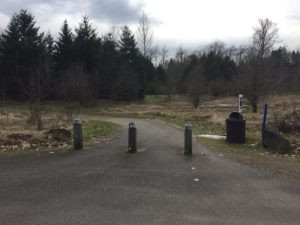 Trail Entrance to Pioneer Park Olympia
Trail Entrance to Pioneer Park Olympia
Embark on a captivating journey through Pioneer Park in Olympia, Washington, starting right from the parking lot where the river trail beckons to your left. As you approach the Deschutes River, you’ll notice a young grove of Douglas firs, a welcoming sign to the natural wonders ahead. To ensure the preservation of this natural haven, please stay on the designated main park trail, respecting private property by avoiding the side trail under the bridge.
Understanding River Dynamics
Take a moment to observe the Deschutes River. Notice its width and the speed of its flow. Historically, rivers like this would have meandered freely across the landscape, creating a rich and diverse ecosystem. This natural meandering is crucial for river health, yet few rivers worldwide retain this free-flowing state due to human interventions like dikes and dams.
Dive Deeper into River Ecology:
- American Rivers – Discover Your River: River Anatomy
- National Geographic – Understanding Rivers
- World Wildlife Fund – Free-flowing Rivers
The Deschutes River, along with other lowland South Sound streams, is primarily rain-dominant. This means that rainfall, rather than snowmelt, dictates its water levels. Consequently, the river experiences its highest and fastest flows during winter and early spring.
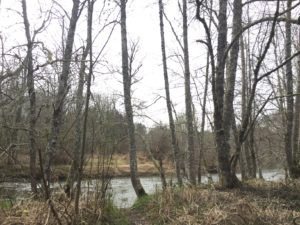 Red Alder Trees along Deschutes River at Pioneer Park
Red Alder Trees along Deschutes River at Pioneer Park
Following the River’s Course
Turning right onto the gravel path, you’ll begin to follow the Deschutes River downstream, tracing its natural flow.
Where Does This River Lead?
Imagine following the Deschutes River to its endpoint. It journeys into Capitol Lake, then passes through a dam and under the 5th Avenue bridge in Olympia, finally merging with the saltwater of Budd Inlet in Puget Sound.
As you walk, observe the deciduous trees lining the riverbanks. Predominantly red alders and black cottonwoods, these trees are well-suited to the damp soil found near streams and rivers. They play a vital role in the ecosystem by providing shade for the river, habitat for various wildlife, and essential nutrients for the soil.
The Impact of Rip-Rap
You might notice sections where the riverbank is reinforced with rip-rap – large boulders placed to create a levee. This construction, likely from the land’s agricultural past or post-flood management, aimed to prevent high water from overflowing the banks. However, this process often involved removing existing vegetation. While alder and cottonwood trees eventually recolonized, non-native plants often outcompeted native shrubs and groundcover in the understory. This shift in vegetation unfortunately diminishes the quality of shelter and food available for local birds, mammals, and other wildlife.
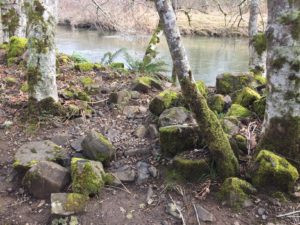 Rip-Rap Riverbank at Pioneer Park Olympia
Rip-Rap Riverbank at Pioneer Park Olympia
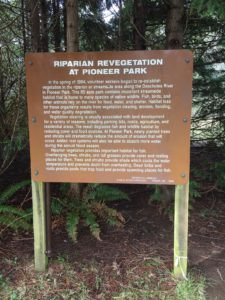 Riparian Revegetation Project Sign at Pioneer Park
Riparian Revegetation Project Sign at Pioneer Park
Riparian Revegetation and Wildlife Habitat
Keep an eye out for a sign detailing an Eagle Scout’s riparian restoration project. This initiative highlights the importance of these zones.
Wildlife in Riparian Habitats
Listen closely and observe your surroundings. What signs of wildlife can you find? Pioneer Park’s riparian area is home to a diverse array of creatures, including singing birds, sunbathing garter snakes, scurrying small mammals, butterflies, raccoons, mice, and even deer.
Understanding Riparian Zones
Riparian areas, as defined by the Washington State Department of Ecology, are the lands adjacent to water bodies and watercourses. These areas are unique due to their distinct soil and vegetation, which are significantly shaped by the presence of water.
Trees and shrubs in riparian zones are essential for maintaining healthy stream ecosystems. They prevent bank erosion, mitigate flooding, and provide shade, which helps to keep the river water cool – vital for aquatic life.
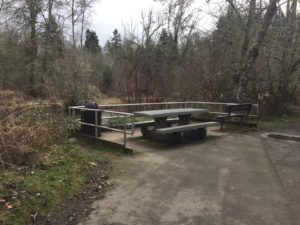 Picnic Bench Overlooking Deschutes River at Pioneer Park
Picnic Bench Overlooking Deschutes River at Pioneer Park
Junction and Riverside Rest
Upon reaching a junction with a paved path, turn right and head back towards the parking lot, staying left on the paved path. Near the picnic table, take another look at the stream bank.
Man-Made Interventions on the Riverbank
Can you spot the man-made rip-rap along this section of the riverbank? As mentioned earlier, rip-rap is used in areas where natural vegetation has been removed. These rock walls are designed to reduce bank erosion by deflecting the force of high water, preventing it from scouring away the soil.
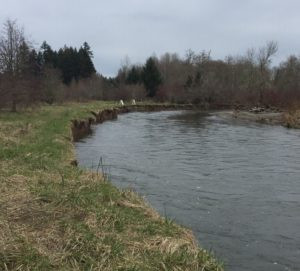 Riverbank Erosion on Deschutes River at Pioneer Park Olympia
Riverbank Erosion on Deschutes River at Pioneer Park Olympia
Returning to the River and Observing Erosion
Near the parking lot, take a left onto the wide gravel path and continue straight, past the life jacket sign, until you are back at the river’s edge.
Evidence of Riverbank Erosion
Observe the riverbanks both upstream and downstream. Do you notice any areas where the banks are collapsing into the river? Please keep a safe distance from the bank as the river is fast-flowing and deep here. The erosion you see is exacerbated by the historical removal of native trees and shrubs. The root systems of these plants would have naturally reinforced the soil, and the overhanging foliage would have lessened the impact of the water’s force. Today, many restoration efforts are underway by landowners, agencies, and volunteers to replant native vegetation along eroding riverbanks.
The Impact of Human Activities on Riverbanks
What caused the disappearance of native shrubs and groundcover along the Deschutes River? Likely, past human activities like farming led to the clearing of trees from these banks. Without tree cover, the riverbanks became more vulnerable to erosion during floods. Trees play a crucial role in slowing down floodwaters and their roots act as anchors, holding the soil together and minimizing erosion.
While erosion is a natural process in a healthy stream system, occurring gradually over time, human interference can accelerate it. When trees are removed, erosion happens much more rapidly, leading to increased sediment in the water and wider, more severely eroded banks than would occur naturally.
A Prime Location for Restoration
This area serves as an excellent example of where tree planting for restoration would be highly beneficial.
Congratulations on Completing Your Exploration!
You’ve reached the end of this section of the trail, having observed firsthand the dynamics of the Deschutes River and the importance of riparian zones within Pioneer Park.
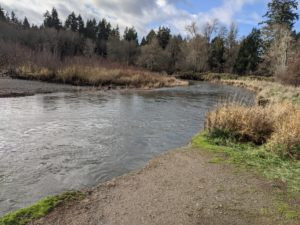 Pioneer Park Trail Sign and Scenery
Pioneer Park Trail Sign and Scenery
To continue your exploration, follow the path and turn right at the gravel intersection. This will lead you back to the parking lot, completing your loop through the natural wonders of Pioneer Park Olympia.
